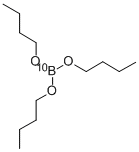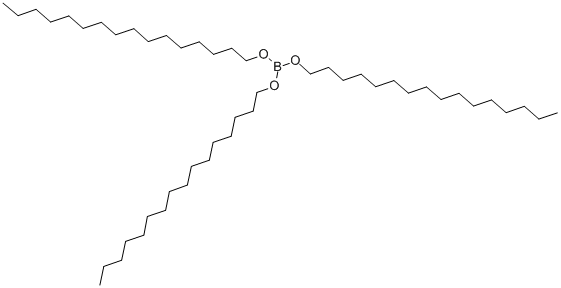TRIPROPYL BORATE
- CAS NO.:688-71-1
- Empirical Formula: C9H21BO3
- Molecular Weight: 188.07
- MDL number: MFCD00009366
- EINECS: 211-703-9
- SAFETY DATA SHEET (SDS)
- Update Date: 2024-12-18 14:08:57

What is TRIPROPYL BORATE?
Chemical properties
Colorless liquid
The Uses of TRIPROPYL BORATE
Tri-n-propyl borate is used as solvents or catalysts for the production of resins, waxes, paints and varnishes, antioxidants, flame retardants. It is also used for petroleum products, tackifiers for silicone elastomers, stabilizers and binders for rubbers or plastics and as cross-linking agents in polymerization processes. They are are used in welding fluxes.
Purification Methods
Dry the ester over sodium and then distil it, preferably in a vacuum. (cf tributyl borate.) [Charnley et al. J Chem Soc 2288 1952, Beilstein 1 IV 1436.]
Properties of TRIPROPYL BORATE
| Melting point: | <0°C |
| Boiling point: | 175-177 °C(lit.) |
| Density | 0.857 g/mL at 25 °C(lit.) |
| refractive index | n |
| Flash point: | 90 °F |
| form | Liquid |
| color | Colorless |
| Specific Gravity | 0.857 |
| Water Solubility | Soluble in organic solvents. Decomposes in water |
| Sensitive | Moisture Sensitive |
| Hydrolytic Sensitivity | 7: reacts slowly with moisture/water |
| CAS DataBase Reference | 688-71-1(CAS DataBase Reference) |
| EPA Substance Registry System | Boric acid (H3BO3), tripropyl ester (688-71-1) |
Safety information for TRIPROPYL BORATE
| Signal word | Warning |
| Pictogram(s) |
 Flame Flammables GHS02  Exclamation Mark Irritant GHS07 |
| GHS Hazard Statements |
H226:Flammable liquids H303:Acute toxicity,oral H315:Skin corrosion/irritation H319:Serious eye damage/eye irritation H320:Serious eye damage/eye irritation H335:Specific target organ toxicity, single exposure;Respiratory tract irritation |
| Precautionary Statement Codes |
P210:Keep away from heat/sparks/open flames/hot surfaces. — No smoking. P233:Keep container tightly closed. P240:Ground/bond container and receiving equipment. P261:Avoid breathing dust/fume/gas/mist/vapours/spray. P264:Wash hands thoroughly after handling. P264:Wash skin thouroughly after handling. P280:Wear protective gloves/protective clothing/eye protection/face protection. P303+P361+P353:IF ON SKIN (or hair): Remove/Take off Immediately all contaminated clothing. Rinse SKIN with water/shower. P305+P351+P338:IF IN EYES: Rinse cautiously with water for several minutes. Remove contact lenses, if present and easy to do. Continuerinsing. P370+P378:In case of fire: Use … for extinction. P405:Store locked up. P403+P235:Store in a well-ventilated place. Keep cool. P501:Dispose of contents/container to..… |
Computed Descriptors for TRIPROPYL BORATE
| InChIKey | LTEHWCSSIHAVOQ-UHFFFAOYSA-N |
New Products
Methyl (R)-1-Boc-4,4-difluoropyrrolidine-2-carboxylate 2,2-Difluoropropylamine hydrochloride tert-butyl 3-bromoazetidine-1-carboxylate (R)-1-Boc-3-hydroxypyrrolidine DIFLUOROACETIC ANHYDRIDE 2,2-Difluoropropionic acid Diallylamine, 99% Calcium hydroxide, 95% Aluminum oxide, basic 2-Bromophenylacetonitrile, 97% L-tert-Leucine,97% N-Hydroxy-2-methylpropanimidamide 4-(3,4-Dichlorophenyl)-3,4-Dihydro-N-Methyl-1-(2H)-Naphthalenimine (Schiff Base) 2-AMINO-3,5-DIBROMO BENZALDEHYDE [ADBA] L-Glutamic Acid Dimethyl Ester Hcl 10-Methoxy-5H-dibenz[b,f]azepine 5-Cyanophthalide N, N-Carbonyldiimidazole (CDI) Dibenzoyl Peroxide Titanium Dioxide 2-(Methylthio) Benzonitrile Sodium Acetate Anhydrous Allopurinol 1,5-DibromopentaneRelated products of tetrahydrofuran








You may like
-
 Tri-n-propyl borate CAS 688-71-1View Details
Tri-n-propyl borate CAS 688-71-1View Details
688-71-1 -
 Tri-n-propyl borate CAS 688-71-1View Details
Tri-n-propyl borate CAS 688-71-1View Details
688-71-1 -
 Tripropyl Borate CAS 688-71-1View Details
Tripropyl Borate CAS 688-71-1View Details
688-71-1 -
 Ethyl-2-Chloroacetoacetate 609-15-4View Details
Ethyl-2-Chloroacetoacetate 609-15-4View Details
609-15-4 -
 CIS- BROMO BENZOATEView Details
CIS- BROMO BENZOATEView Details
61397-56-6 -
 609-15-4View Details
609-15-4View Details
609-15-4 -
![1-(6-Methylpyridin-3-Yl)-2-[4-(Methylsulfonyl)Phenyl]Ethanone [Ketosulfone] 99%](https://img.chemicalbook.in//Content/image/CP5.jpg) 1-(6-Methylpyridin-3-Yl)-2-[4-(Methylsulfonyl)Phenyl]Ethanone [Ketosulfone] 99%View Details
1-(6-Methylpyridin-3-Yl)-2-[4-(Methylsulfonyl)Phenyl]Ethanone [Ketosulfone] 99%View Details
221615-75-4 -
 27143-07-3View Details
27143-07-3View Details
27143-07-3
Statement: All products displayed on this website are only used for non medical purposes such as industrial applications or scientific research, and cannot be used for clinical diagnosis or treatment of humans or animals. They are not medicinal or edible.
